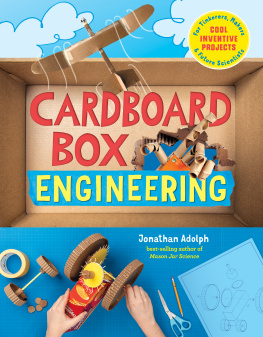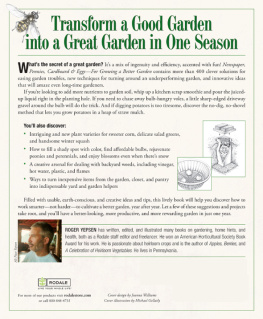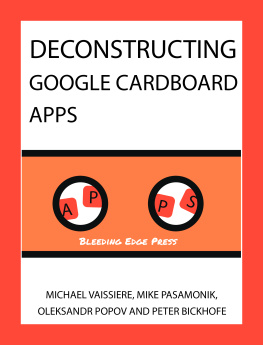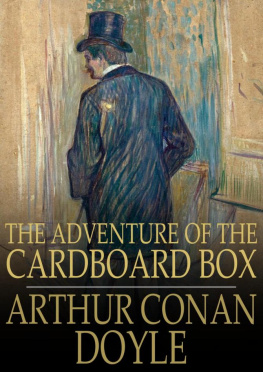THE ART OF CARDBOARD
BIG IDEAS FOR CREATIVITY, COLLABORATION, STORYTELLING, AND REUSE
Maikai Tubbs The Comforts of Home 2014
LORI ZIMMER

2015 by Rockport Publishers
Text 2015 Rockport Publishers
First published in the United States of America
in 2015 by Rockport Publishers, a member of
Quarto Publishing Group USA Inc.
100 Cummings Center
Suite 406-L
Beverly, Massachusetts 01915-6101
Telephone: (978) 282-9590
Fax: (978) 283-2742
www.rockpub.com
Visit RockPaperInk.com to share your opinions, creations, and passion for design.
All rights reserved. No part of this book may be reproduced in any form without written permission of the copyright owners. All images in this book have been reproduced with the knowledge and prior consent of the artists concerned, and no responsibility is accepted by producer, publisher, or printer for any infringement of copyright or otherwise, arising from the contents of this publication. Every effort has been made to ensure that credits accurately comply with information supplied. We apologize for any inaccuracies that may have occurred and will resolve inaccurate or missing information in a subsequent reprinting of the book.
10 9 8 7 6 5 4 3 2 1
Digital edition: 978-1-62788-357-3
Softcover edition: 978-1-63159-027-6
Digital edition published in 2015
Library of Congress Cataloging-in-Publication Data
Zimmer, Lori.
The art of cardboard : big ideas for creativity, collaboration, storytelling, and reuse / Lori Zimmer.
pages cm
ISBN 978-1-63159-027-6 (hardback)
1. Cardboard art. I. Title.
N6494.P34Z56 2015
745.54--dc23
2014049445
Design: Timothy Samara
Photos courtesy of the artists unless otherwise noted.

For my parents Cindy and Gil, who supported me no matter what in all of my weird art adventures.
CONTENTS
WHY CARDBOARD?
INTRODUCTION
James Grashow Corrugated Fountain 2012
Cardboard. We use it in our day-to-day lives, to ship our packages, to move our belongings to a new home, or to store our old stuff in the garage. As children, cardboard becomes the bare bones for our fantasiesturning leftover corrugated boxes into play houses, time machines, and spaceships. It is in this spirit that a roster of artists are using cardboard as their chosen medium today, treating the mundane material as if it were the element needed for a fine work of art. From crafting to furniture-making to fine art, a new cast of creatives have redefined cardboard as a viable material of the future, in both art and design.
Many factors have attracted artists to the allure of cardboard, with the foremost being the obviousaccessibility. We can all relate to utilizing cardboard around the house to whip up a Halloween costume or school project. Because it seems essentially free, it also gives the impression of being more forgiving. Without the fear of ruining a precious material, we delve into our greatest creative notions, unafraid of messing up the results. Although we are proud of our cardboard craft creations, fine artists take the material to the next level, using their skills and creativity to transform the mundane material into a luxurious and versatile medium.
Daniel Agdag The Second Decline 2013
Some artists have turned to cardboard in the spirit of the trend toward sustainability and eco-consciousness. Sourcing cardboard from recycling bins, trash piles, or from their own consumer use, these eco-artists use cardboard as a way to convey their message, tying in commentary about environmentalism with their pieces by making the viewer aware of the material in the artwork, sometimes by leaving labels and printing unaltered. Artists such as Andy Barrett and the couple behind Cardboard Box Office leave their materials as is, integrating the texture and former life of cardboard into their pieces.
Another allure of cardboard is its malleability and easily manipulated surface. Rather than chiseling away at marble or working with a tougher material, artists can bend, contort, cut, and glue cardboard at will using simpler tools like X-Acto blades, scissors, and glue. With an artists touch, the material can be rendered sleek and smooth, appearing like a more expensive or rigid medium. This transformative property itself inspires, opening up possibilities that other materials may prevent. With cardboard, artists have found they can let their imaginations run wild. Ornate Baroque frames take on a new meaning of modernity and conceptuality with the work of Jillian Salik, transcending from design object to work of art by sheer choice of material. Chris Gilmour, one of the more prominent users of cardboard in art, has taken inspiration from the everyday material to recreate life-size versions of everyday things, like cars, typewriters, and dentist chairs, all made with meticulous detail and accuracy.
Taro Hattori Obscenity Version 1 2010
While these artists use their magic to transform cardboard into smooth and taut surfaces, others can leave the medium entirely unrecognizable. Ann Webers process for her sculptural installations leaves the cardboard looking like woven bamboo or fine wood, yet much less heavy. Chicago-based artist Jzef Sumichrast uses a sander on his cardboard sculptures to give a velvety surface that fools the eye into thinking it is a much heavier material. Daniel Agdags work uses the flexibility of cardboard to make intricate mechanical-inspired models with delicate tiny parts. Agdag emphasizes his imposed value on the material by placing the sculptures under bell jarswhich were used to house curiosities and treasures in the Victorian era.
The versatility and easy to use quality of cardboard also allows artists to dream bigand make enormous installations with greater ease than working with heavier materials like marble, metal, and wood. Taro Hattori creates oversized models of planes and tanks that skew the viewers perspective as they are jammed into an interior, while Laurence Vallires takes advantage of the material to make giant scenes of the animal kingdom with a scale that makes them hauntingly real. Cardboard is also the perfect material to create fantastical versions of reality, like Dosshauss black and white distortions that transform daily life into a life-size childrens book.
Andy Barrett Bonfire 2012
The affordability, availability, sustainability, and forgiving nature of the medium of cardboard have influenced a new genre of artists to not only experiment, but to spark their imaginations and render a utilitarian material sometimes unrecognizable. The accessible medium inspires the inner artist in all of us and has that rare quality that beckons the viewer to go home and try their hand at making something creative themselves.















